
Issue #: 145
Published: January / February 2016
- Price per issue - digital : 5.40€Digital magazine
- Price per issue - print : 6.20€Print magazine
- Access to Multihulls World digital archives Digital archives
A circumnavigation is about creating wonderful memories of idyllic anchorages and dream sailing. But, there are also a few memories which are not quite so painless…!
If there’s one thing in particular (among many) which I loved about our trip round the world, it was the sense of accomplishment which can only come from having circumnavigated, that is to say getting back to your point of departure, having sailed through 360° of longitude. And definitely returning to the same port…! I am often asked what was the most dangerous part of our trip round the world in our catamaran, which saw us sailing as far as New Zealand, and then returning to Europe via South Africa? People suggest storms far out to sea, someone falling overboard, or even pirates. To the surprise of the audience, I always tell them that it was the powerful squalls we experienced at anchor, commonly in the latter half of the night, and most particularly in the western Pacific. It is these which left me with the worst memories. On at least three occasions, they could easily have set our sailboat on the shore, despite having been meticulous in our anchoring technique…
My little family crew and I, just us, in a far-off corner of the Ha’apai archipelago avoided one of the perils of the sea. A place I had already named the “Dangerous Archipelago”. What memories…
Islands, islets, reefs just awash. Lots of reefs. Current, often strong. And breakers, ever present on the horizon, wherever you look. Inaccurate charts, but that’s not really the problem, as navigation is mostly done visually round here. We’re not really talking about experience here - after all, there must be some worse nautical CVs than mine, but that’s not the problem here either. The truth remains that the sea is a good teacher of humility. And it’s not only those who sail to far away and deserted lands who shouldn’t forget it.
The previous day. Marin and Adélie on the deserted beach at Limu, Ha’apai.
Following a short stopover in Nomuka, alone once again, we spent the afternoon anchored close to the wreck of a Korean fishing boat. The sea was breaking loudly on a nearby shoal. Atmosphere. The following day we went back to Fonuafua island, another of Ha’apai’s precarious anchorages. In the late afternoon we visited the island’s tiny village, chatted with the schoolteacher and answered a few of the kids’ questions. The anchorage was calm that night. That is to say that I only got up two or three times for a quick look round to check, making the most of what, for me, is the end of a sleep cycle. The geography of the Ha’apai Group is complex, and you have to spend some time working out a coherent route for cruising round it. We decided to head for a solitary island, sheltered by a long barrier reef, Limu Island, located twenty-odd miles to the northeast. Fate had something in store for us, but we didn’t yet know it. We zigzagged all morning between the clearly visible reefs and mid-afternoon arrived off Limu.
Everything was just right for approaching a coral anchorage: fine weather was forecast, and we were arriving at the best time (with the afternoon sun at our backs). I climbed to the spreaders to give pilotage instructions to Barabara who was at the helm whilst Marin kept watch at the bow, and started the anchoring process. Adélie called out the depth every 10 seconds from the sounder, and ensured communication between the other three of us. A tried and tested method. The electronic chart was 2 to 300 meters out, something very common when you zoom in to the detail in these isolated and little-frequented anchorages.
We found a good place to anchor in 4.5 meters of water, with a white sand bottom and 360° swinging room and a safety margin of 40 meters, at two cables (1 British Admiralty cable = 100 fathoms or approximately 183 meters) downwind of Limu. We fed out the chain, backing up nice and straight, and gave a first pull on it at 40 meters with the motors, then a second pull with 65 meters out and the motors at 1,200 rpm. It was good and solid, and the anchor felt well dug-in. As usual, when moored for the night around coral (with no possibility of escape in the dark due to the surrounding reefs), I dove in to check the anchor’s position and the lie of the chain. The hook was definitely well buried in the sand, and the chain perfectly stretched out. The tidal range here is less than one meter, and we had 65 meters of chain out in a depth of 4 meters (when I hear people say “3 times the depth of water”, this always grates with me, as you should never anchor with less than 35 meters of chain, even with only one meter under the keels!)
An easterly wind was blowing at 10 knots, as per the forecast for the night. We were downwind of the barrier reef and downwind of the island. So I had no reason to consider setting a tandem anchor or a Bahamian mooring. We stopped the motors, lowered the dinghy and went ashore on Limu’s immaculate beach. There was a deserted fishermen’s camp, evidence of a campfire and hundreds of birds. We walked round the small island, the kids played in the water and then went looking for shells on the beach. I went into the foliage a bit in the middle of the island and saw the nest of black noddy birds, most of which had chicks. I read somewhere that this island was also home to sea snakes, but for now they were keeping themselves hidden. We were back on board the boat by sundown. The weather was cloudy, but calm.
On the far side of the world, on the beach at Limu, a well-known brand…
October 17th. Around 2am I was woken by rain falling on the deck: I got up and did a tour around the boat. The weather had deteriorated a bit, the sky was now overcast, looking loaded, the wind had shifted through 30° and was blowing at 12 knots. Nothing particularly alarming. Anyway, it would have been out of the question to leave the anchorage in the dark (even with our track in recorded on the plotter) - the approach was littered with dangers, some only a few meters apart, as is the case in a good number of anchorages in the Ha’apai Group. Only in daylight can one anchor. Here and there, the anchorages can become a trap, from which there is no escape. I know this perfectly well: you’ve just got to hang in there. No other options. I went back to bed.
Around 04.20 I was suddenly woken by a violent squall which hit the anchorage without warning. In a few seconds, rain was hammering down on the deck, with gusts up to 35 knots whistling through the rigging. On deck everything was obscured, the night was black and the rain like a thick curtain. My headlamp was useless. It lit up a deluge which became opaque 3 meters in front of me. Visibility was effectively nil. I started the motors, switched on the radar, concluded that the wind had suddenly shifted 150° with the squall, and was now blowing out of the southwest! It was now gusting to 40 knots… I was starting to get concerned. I recalled our arrival the previous afternoon, winding our way between the coral heads. In the din of the driving rain and gusts of wind, it didn’t feel to me as though the anchor was dragging.
I had deliberately not set the anchor bridle the previous day (to better feel the behavior of the chain on the metal fittings at the bow). I preferred not to lengthen the chain (80 meters on the main anchor), as I was not able to tell the distance separating us from the coral behind. The sounder was showing 3.5 meters! I put the motors slow ahead to take some load off the chain, but without letting it go slack. In just a few seconds I was soaked to the skin and freezing cold. I quickly woke my little crew, pulled on a jacket and went back on deck. I know danger all too well. But we could see nothing, and with a chop starting to quickly form, it was impossible to know where the coral was around us. So unfortunately there was little we could do. Weighing anchor and trying to put to sea would have been sheer madness. Letting out more chain would certainly have put us aground. Setting a second anchor from the dinghy in this weather was unthinkable, far too dangerous. I would rather keep my 12 year-old son at my side. All we could do was to hope that the anchor held well in the sand, or that if it did start to drag, that it hooked up on a coral bommie. 65 meters of chain in 4 meters of water. It’d better hold! Damned squall!
Captain’s orders: Watch out for the western Pacific’s powerful squalls when you’re anchored overnight!
Just a few seconds later, before I could make out what was going on, I felt the keels touch, little taps at first, not violent, but perceptible. Shit! It can’t be true! We were grounding, starting to go up on the coral! In the black, hostile night, only broken by violent lightning bolts, the rage of the wind and the heavy noise of the rain, I realized this might be a turning point in our trip around the world. I was struggling to understand exactly what was going on, why we were now disorientated, what we were aground on, and worse, where the island was…? The only thing I was certain of was that we had dragged, and were still dragging in the gusts! There was no way of knowing which way we should try and go!
The chain seemed to have normal tension, no jerking particularly, no unusual vibration, we were simply slipping in the soft sand… The anchor must have come free with the sudden pull from the chain in almost the opposite direction. We were sliding inexorably over the coral. I put Marin in charge of the windlass, and told him to start slowly hauling in the chain while I came ahead with the motors. I was trying to free the boat under power, in the direction of the anchor chain, but I quickly realized this was not going to be so easy. We were already hooked up on the coral. The idea that we might lose the boat here, and that our voyage might end at Limu Island in Tonga, ran through my mind. I forced the thought from my mind, as if our lives depended on it.
The chain now came up freely. But there were still 50 meters of it out! There was no point in using more power, and risking the propellers and saildrives. The squall was easing a little. In the dark night, the cold and the rain and the wind, we lowered the dinghy into the water. In the loom of our headlamps, Marin and I got in and loaded our lightweight Fortress anchor and set about laying out 100 meters of rode upwind. Pulling with a winch did nothing, as the port keel was already stuck in the coral. We had to contend with pivoting the boat in the direction we assumed was best for getting free. Doing any more would have been a waste of time. It was annoying, but we had to accept the situation. The only good idea would have been never to have come here in the first place, to this anchorage at Limu which now in the early hours, had us penned in. Already, the squall was weakening and we didn’t need to scream to be heard! The crew was in no immediate physical danger, and the island, although deserted, was only a few hundred meters away. I felt bad for my boat. I felt sick. Although the boat had really pounded, the keels had grounded for a few seconds, then settled on the coral on a falling tide. We were now stuck fast. I told myself the only thing was to keep patient. Remain calm and reassure my little crew who were in shock, though still extremely alert. The Ha’apai islands were just giving us a warning. A serious warning.
The tide was dropping and the powerful black squall was moving away. The tide quickly set us down on our keels, and to an extent on our rudders as well, which wouldn’t move. At this point I felt glad we had chosen a catamaran with fixed skeg keels. I’m sure that on a cat with daggerboards, the damage would have been much more significant, especially to the rudder blades and saildrives, and the underside of the hulls as well.
The strongest of the squall had passed in the space of 15 or 20 minutes. The weather calmed rapidly. The first rays of the dawn threw a hazy light over Limu island. The chop had dropped away as quickly as it had come up. It was raining. We felt like prisoners on a little coral flat only a few dozen meters from the coast, isolated on the white sand. We had steadily dragged a good hundred meters. I put my wetsuit on and dove under the boat. The damage was minimal. The propellers and the saildrives hadn’t touched the coral, and only the sacrificial keels had been damaged by the coral, up to a height of about 30 cm. There was no chance that our keels could have passed a few centimeters over the coral on the falling tide. Only ten meters separated us from clear water. In all this bad luck, everything was ok.
I climbed back aboard and asked for a nice hot coffee, and encouraged everyone to eat a good breakfast. We were going to need our energy! The boat was listing a few degrees to starboard, and we were not used to this discomfort! I put out a call on VHF 16. No response. I didn’t try again. Quickly, using the Iridium phone, I called my brother in France, giving him our position and telling him that we were fast on the coral, but that I wasn’t particularly concerned, and above all, not to do anything. I explained the situation to my little crew, much affected by the events, but united and willing. Things weren’t too bad as long as the weather stayed calm. I set out my plan for getting the boat out of this situation. I detailed the tasks. I promised everyone we’d be afloat in clear water in a few hours’ time. And in the worst case scenario, Limu Island was very close by.
I could feel the tension, the concentration, but no-one seemed over-worried. I even managed to make a bit of fun to keep everyone’s morale high. I guessed however, that the recent unfortunate events at Kelefesia with La Tortue (see Multihulls World No.144) were not far from their minds… But my optimism bore fruit. No-one was despondent, just a bit concerned. Marin put his wetsuit on as well, as we gathered all the equipment on deck. Barbara and Adélie stayed on board while Marin and I took to the dinghy.
We started with the most difficult job - hauling up the main anchor and chain by hand into the tender, so we could go and reposition it further off, in the right direction. I cut the bitter end, the girls let it out on the windlass. The dinghy was well down in the water, but we succeeded in carrying the anchor 180 meters in the direction the boat needed to go. We slowly set out the chain, and Marin dove to bury the plough anchor, then we led the extremity of the rode back to the windlass gypsy. We set it tight, ready to haul in. I was satisfied with this first stage of the operation. We lifted the light Fortress anchor (surprisingly effective holding - we had already experimented with this) which we had previously set, and took it to 150 meters from the boat at 20° to starboard. The line came back via a fairlead, to the starboard sheet winch. With a bit of tension, the anchor dug in - we checked by diving - and the second mooring line was ready for pulling the boat. Both were marked with anchor buoys.
Jangada was hauled a few weeks after her stay on the coral, at Norsand Boatyard in Whangarei, New Zealand, for a long-awaited refit following 18,000 miles at sea.
But that wasn’t all: once free, we would need to be able to hold the boat from going up on any one of the many coral heads scattered here! We set our third anchor 120 meters aft to port, at the edge of the reef. In all, the work took us nearly three hours. During this time, Barbara prepared us a huge plateful of pasta with olive oil and basil. We recovered our strength. The weather remained stable and the wind moderate. I was optimistic. The tide had been rising since 9 o’clock, and the boat was starting to level up again. We were ready. I kept diving in to check the situation under the water, and Adélie was put in charge of an essential job: my close protection! From the deck, she kept an eye on the yellow and black sea snake we’d seen several times through the morning around the boat, making sure it didn’t get too close to Dad! Adélie can be very motivated! It was the biggest snake we had seen so far, around 1.50 meters long, and it would be best avoided in face to face combat! I constantly tried to keep an eye around my perimeter, speargun in hand, and I saw this impressive snake, in his element, inspecting the hulls of our sailboat, sliding between the coral and disappearing behind the seaweed then coming back toward me, menacingly... I faced him, and then he stopped, backed off slowly, but was never very far away. It was a highly-charged moment that I remember well.
I set up a line of fenders which I forced under the water using a winch around the port hull, aft, so as to try and keep the tip of the rudder blade from touching the coral on that side. The extra flotation given by the fenders gave us a good ten centimeters extra at the waterline. The starboard keel came free at 12:45. I took up a bit of tension on the two mooring lines forward. At 13:25, the boat started to make progress toward the open water. No sense in trying to force it: the weather was stable, the sea calm. All we had to do was wait.
Ten minutes later, I took up a bit more tension on the main anchor. Shortly after, the boat was clear of the coral, and we felt two or three little taps from the keels which were just touching lightly as we made our way toward the clear water, then the boat was floating once again above clear sand. We were free from the grip of the coral! I pulled in on the aft line, and kept the boat still. I let out a victory cry, and saw Barbara’s face light up with a smile. I knew she had been worried, but also she had been frightened. Adélie was relieved as well. She had taken on a lot these last few hours, and paid great attention to the little jobs I’d given her to do. Marin had been super-efficient all morning, helping me get the anchors in position. Junior is growing up! The yellow and black snake was still there on the coral flats. No bad thing. We inspected the keels: a little bit of work needed underneath, a few scrapes, but no structural damage. The hulls and the propellers were untouched. I reconnected the rudders, we lifted the secondary anchors one at a time, then the main anchor line, which was stowed back in the chain locker. The motors purred. We decided to make for Pangaï, the main village in the Ha’apai Group, 20 miles to the north. Night fell gently on the village’s sheltered bay. Double rum punch for the grown-ups, and as much fruit juice for the kids as they could drink!
We hauled out in New Zealand. Looking back, I think of the route which took us there. We had long had a refit booked with a yard in Whangarei, and we now had to use this to sort out the laminate on the lower part of the keels. But before this, I wanted to stop off at the volcanic island of Tofua, whose massive outline I had been able to see on the western horizon for some days. I’d had an idea in my head for a few months now. It had come to me when we were anchored in the Las Perlas Islands off Panama, while I was studying the chart of the Pacific islands trying to plan out our route across this great ocean. I wanted to make a little historic detour, to try and find the cave used by Captain Bligh when he was freshly disembarked from the Bounty, along with his few crew who remained loyal, at the hands of Fletcher Christian’s mutineers.
Only if the wind would let us, while sailing toward the land of the kiwi.
The time had come to for us to leave the dangerous archipelago. We need to know how to interpret the signs. Sailors learn to become superstitious. But our adventure continues. Jangada had paid her dues to the Ha’apai Islands…
The catamaran’s starboard keel. Scratched by the sharp coral, Jangada’s fine, narrow, deep keels were re-laminated after drying out.
The tips of Jangada’s rudder blades were marked by the coral, but there was no structural damage. They were made as good as new, and the self-aligning rudder bearings were replaced.
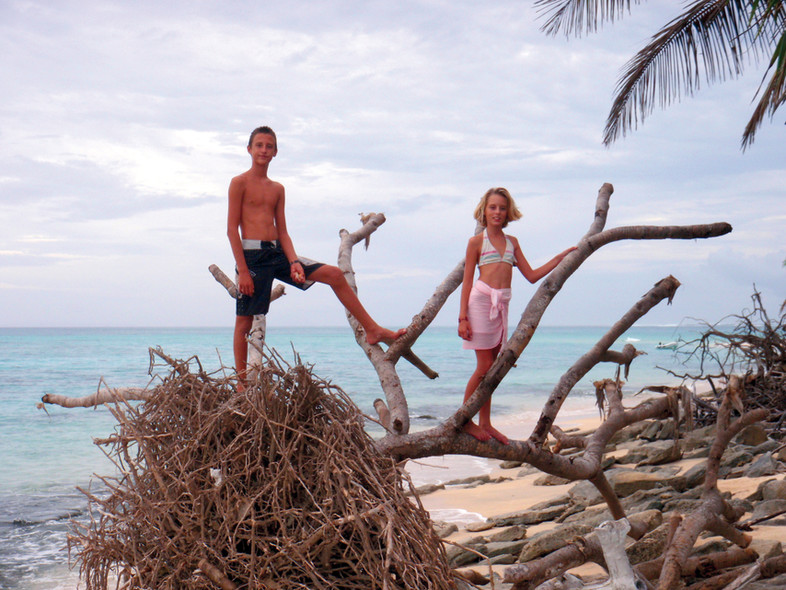
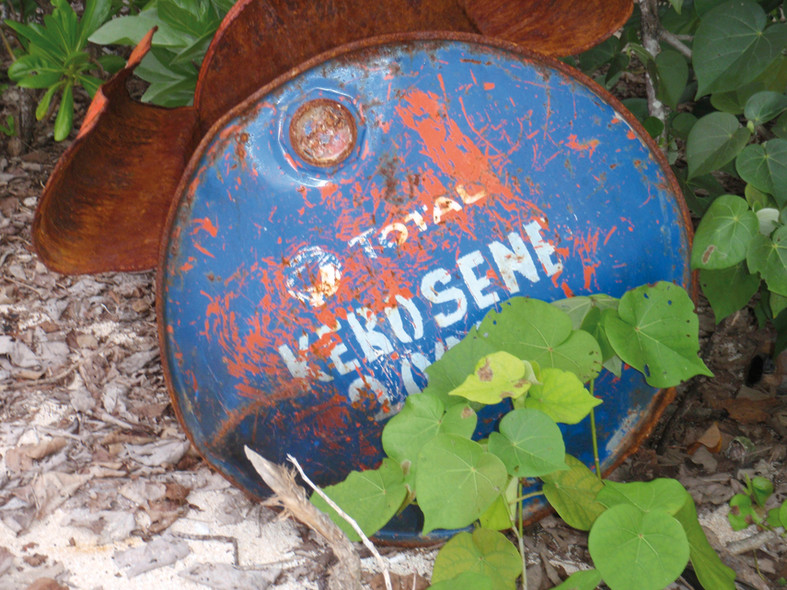
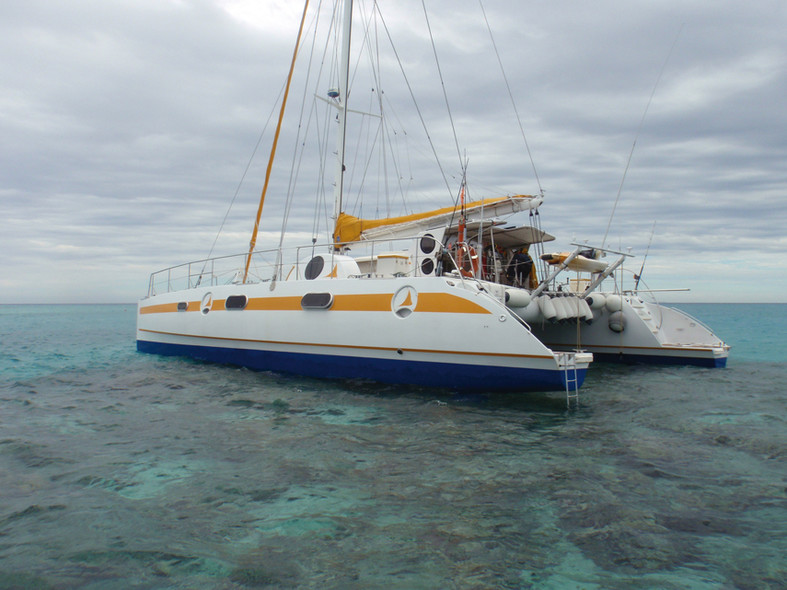
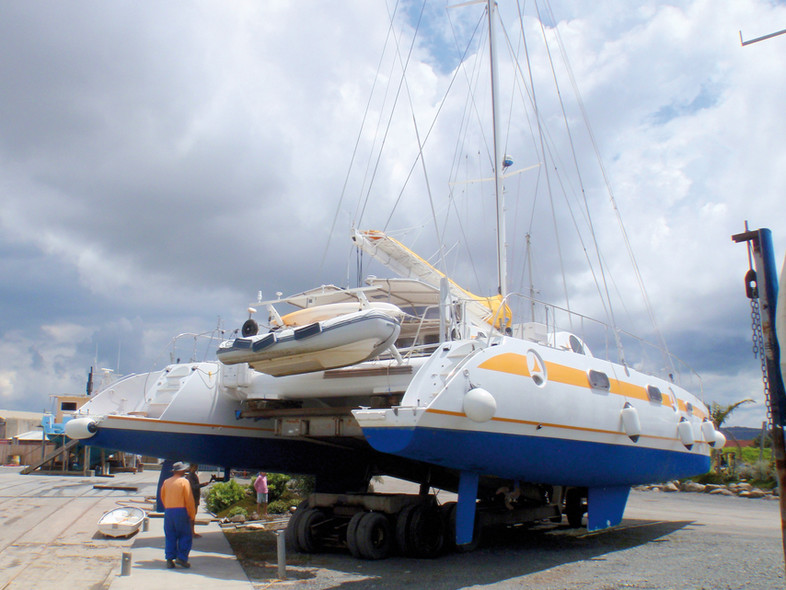
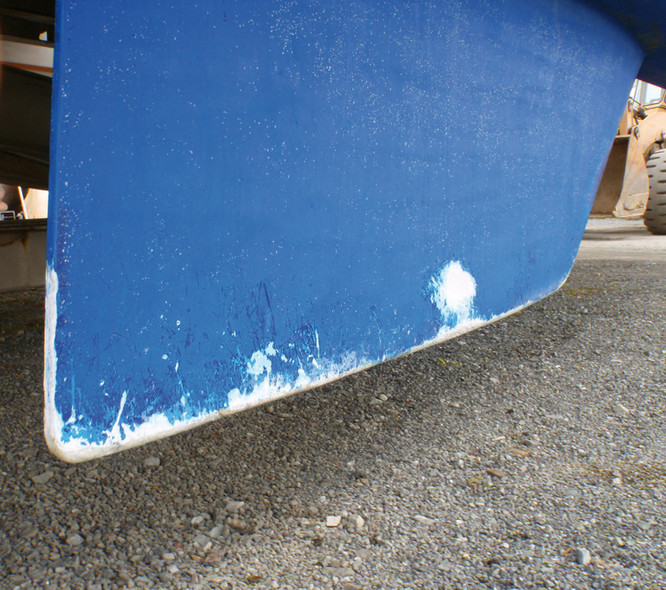
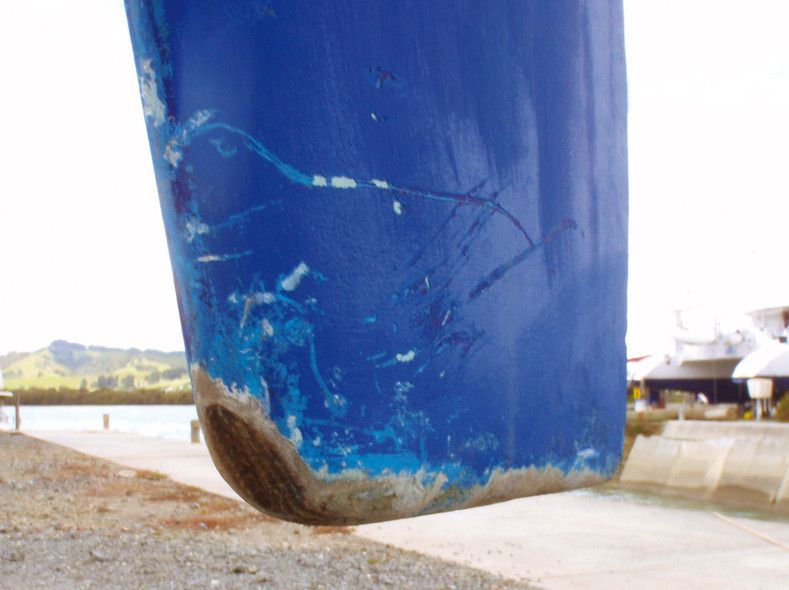
What readers think
Post a comment
No comments to show.